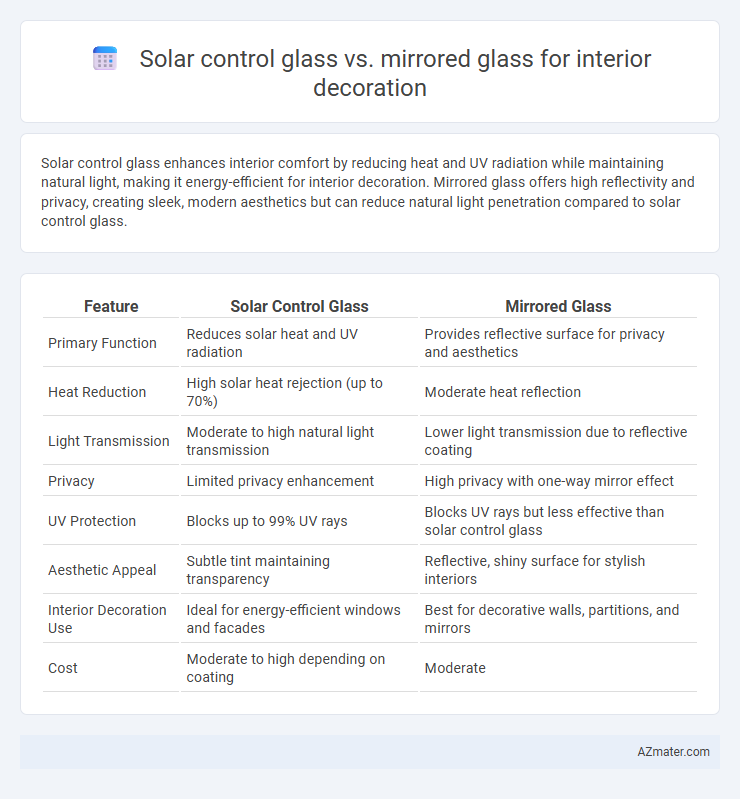Solar control glass enhances interior comfort by reducing heat and UV radiation while maintaining natural light, making it energy-efficient for interior decoration. Mirrored glass offers high reflectivity and privacy, creating sleek, modern aesthetics but can reduce natural light penetration compared to solar control glass.
Table of Comparison
| Feature | Solar Control Glass | Mirrored Glass |
|---|---|---|
| Primary Function | Reduces solar heat and UV radiation | Provides reflective surface for privacy and aesthetics |
| Heat Reduction | High solar heat rejection (up to 70%) | Moderate heat reflection |
| Light Transmission | Moderate to high natural light transmission | Lower light transmission due to reflective coating |
| Privacy | Limited privacy enhancement | High privacy with one-way mirror effect |
| UV Protection | Blocks up to 99% UV rays | Blocks UV rays but less effective than solar control glass |
| Aesthetic Appeal | Subtle tint maintaining transparency | Reflective, shiny surface for stylish interiors |
| Interior Decoration Use | Ideal for energy-efficient windows and facades | Best for decorative walls, partitions, and mirrors |
| Cost | Moderate to high depending on coating | Moderate |
Introduction to Solar Control Glass and Mirrored Glass
Solar control glass enhances interior decoration by reducing heat and glare through specialized coatings that reflect infrared and UV rays, improving energy efficiency while maintaining natural light. Mirrored glass creates striking interior aesthetics with its reflective surface, offering privacy and visually expanding spaces while controlling light transmission. Both types optimize comfort and design, with solar control glass focusing on thermal regulation and mirrored glass emphasizing reflection and privacy.
Key Characteristics of Solar Control Glass
Solar control glass features a low-emissivity coating that reduces heat gain by reflecting infrared radiation while maintaining high visible light transmission, enhancing energy efficiency in interior spaces. It minimizes glare and UV rays, protecting furniture and fabrics from fading, making it ideal for sun-exposed rooms. Unlike mirrored glass which creates a reflective surface, solar control glass preserves transparency, allowing natural daylight without compromising thermal comfort.
Defining Features of Mirrored Glass
Mirrored glass features a reflective coating that provides privacy by limiting visibility from one side while allowing light to pass through, making it ideal for interior decoration where both aesthetics and functionality matter. This glass type reduces solar heat gain by reflecting sunlight, contributing to energy efficiency in indoor environments. Its ability to create a visually striking effect enhances modern interior designs by incorporating privacy with decorative elegance.
Aesthetic Impact on Interior Spaces
Solar control glass enhances interior aesthetics by allowing natural light while reducing glare and heat, creating a comfortable and bright environment that preserves color vibrancy in furnishings. Mirrored glass adds a striking visual element by reflecting surroundings, amplifying space perception and introducing a sleek, modern look that complements minimalist and contemporary designs. Both options influence ambiance significantly, with solar control glass favoring subtlety and energy efficiency, while mirrored glass emphasizes boldness and spatial expansion.
Energy Efficiency and Light Regulation
Solar control glass enhances energy efficiency by reducing heat gain through its low-emissivity coatings, which help maintain indoor temperatures and lower cooling costs in interior spaces. Mirrored glass excels in light regulation by reflecting glare and providing privacy, yet it can trap heat, potentially increasing cooling demands compared to solar control glass. Choosing between solar control and mirrored glass depends on balancing heat insulation needs with light reflection requirements for optimal interior environmental comfort.
Privacy and Reflectivity Considerations
Solar control glass offers superior privacy by reducing heat and glare while maintaining natural light transmission, making it ideal for interior spaces requiring comfort and discretion. Mirrored glass enhances privacy through its one-way reflective surface, creating a visually striking barrier but can reduce natural light and views from inside. Reflectivity in solar control glass is moderate to minimize external heat gain, whereas mirrored glass exhibits high reflectivity, impacting interior ambiance and energy efficiency.
Durability and Maintenance Requirements
Solar control glass offers superior durability due to its ability to withstand harsh UV radiation and temperature fluctuations, making it ideal for long-term interior applications. Its low-maintenance surface resists dirt and smudges, reducing cleaning frequency and costs. Mirrored glass, while visually striking, often requires more frequent maintenance to prevent scratches and degradation of the reflective coating.
Cost Comparison and Installation Factors
Solar control glass typically costs more upfront than mirrored glass due to advanced coatings that reduce heat and UV transmission, enhancing energy efficiency in interior spaces. Mirrored glass tends to be less expensive and offers aesthetic appeal but provides limited solar control, which may increase cooling costs over time. Installation of solar control glass can require careful handling and professional expertise to preserve its performance coatings, while mirrored glass is generally easier and quicker to install but may need additional shading solutions to manage indoor temperature effectively.
Sustainability and Environmental Impact
Solar control glass enhances energy efficiency by reducing heat transfer, leading to lower cooling costs and decreased carbon emissions, supporting sustainable building practices. Mirrored glass, while effective in reflecting sunlight, may contribute to increased energy consumption internally due to reduced natural light penetration. Choosing solar control glass promotes environmental responsibility through improved thermal performance and reduced reliance on artificial climate control systems.
Choosing the Right Glass for Interior Decoration
Solar control glass reduces heat gain and glare in interior spaces by filtering infrared and ultraviolet rays, enhancing energy efficiency and occupant comfort. Mirrored glass offers privacy and aesthetic appeal through reflective surfaces that bounce light and create a spacious feel, making it ideal for modern or minimalist designs. Selecting the right glass depends on balancing functional needs like solar protection with desired visual effects to optimize interior ambiance and performance.

Infographic: Solar control glass vs Mirrored glass for Interior decoration
 azmater.com
azmater.com